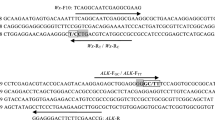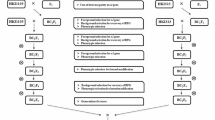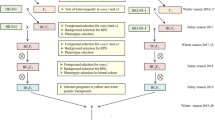Abstract
Waxy maize is popular for food-, feed- and industrial usage. It possesses a recessive waxy1 (wx1) gene that enhances amylopectin to ~ 95–100%, compared to ~ 70–75% in traditional maize. Marker-assisted selection (MAS) is a preferred approach to converting normal maize into a waxy version. However, it requires specialized expertise, a well-equipped laboratory, and high cost. Here, pollen staining was used as an alternative approach to MAS. BC1F1, BC1F2 and BC2F2 populations in seven genetic backgrounds segregating for the wx1 gene were used. Pollens treated with iodine-potassium iodide showed that wild types (Wx1Wx1) were dark purple, while waxy pollens (wx1wx1) exhibited red colour. Heterozygotes (Wx1wx1) showed a mix of both dark purple and red colour. Staining of endosperm flour also confirmed the same findings. Wx1-based genotyping using phi022 and wx2507F/RG confirmed the same genotypic status. The average amylopectin among genotypes having red coloured pollens was 97.6%, while it was 72.5% among dark purple. Heterozygotes with both dark purple and red pollens had 85.2% amylopectin. Pollen staining showed complete agreement with the genotyping as well as amylopectin contents. Pollen staining saved 81% cost, and 54% time compared to MAS. This is the first report on the utilization of pollen staining for selecting the wx1 allele in segregating populations used for the development of waxy maize hybrids.



Similar content being viewed by others
Change history
07 December 2022
A Correction to this paper has been published: https://doi.org/10.1007/s12298-022-01256-7
References
Bao JD, Yao JQ, Zhu JQ (2012) Identification of glutinous maize landraces and inbred lines with altered transcription of waxy gene. Mol Breed 30:1707–1714
Bao-Rong Lu, Chen JK, Song ZP (2001) A study of pollen viability and longevity in Oryza rufipogon, O. sativa, and their hybrids. Int Rice Res Notes 26:1–1
Behall KM, Hallfrisch J (2002) Plasma glucose and insulin reduction after consumption of breads varying in amylose content. Eur J Clin Nutr 56:913–920. https://doi.org/10.1038/sj.ejcn.1601411
Brimhall B, Sprague GF, Sass JE (1945) A new waxy allele in corn and its effect on the properties of the endosperm starch. J Agronomy 37:937–944
Collins NE, Moran ET, Stilborn HL (2003) Performance of broilers feed normal and waxy corn diets formulated with chick and rooster derived apparent metabolizable energy values for the grains. J Appl Poult Res 12:196–206
Devi EL, Chhabra R, Jaiswal SK, Hossain F, Zunjare RU, Goswami R, Muthusamy V, Baveja A, Dosad S (2017) Microsatellite marker-based characterization of waxy maize inbreds for their utilization in hybrid breeding. 3 Biotech 7:316. https://doi.org/10.1007/s13205-017-0946-8
Gao H, Gadlage MJ, Lafitte HR et al (2020) Superior field performance of waxy corn engineered using CRISPR–Cas9. Nat Biotechnol 38:579–581. https://doi.org/10.1038/s41587-020-0444-0
Gerard C, Barron C, Colonna P, Planchot V (2001) Amylose determination in genetically modified starches. Carbohyd Polym 44(1):19–27
Gibbon BC, Wang X, Larkins BA (2003) Altered starch structure is associated with endosperm modification in Quality Protein Maize. Proc Natl Acad Sci 100:15329–15334
Gidley MJ, Bulpin PV (1987) Crystallisation of malto-oligosaccharides as model of the crystalline forms of starch: Minimum chain-length requirement for the formation of double helices. Carbohydrate Res 161:291–300
Gupta HS, Raman B, Agrawal PK, Mahajan V, Hossain F, Nepolean T (2013) Accelerated development of quality protein maize hybrid through marker-assisted introgression of opaque2 allele. Plant Breed 132:77–82
Hashimoto N, Ito Y, Han KH, Shimada K, Sekikawa M, Topping DL, Bird AR, Noda T, Chiji H, Fukushima M (2006) Potato pulps lowered the serum cholesterol and triglyceride levels in rats. J Nutr Sci Vitaminol 52:445–450. https://doi.org/10.3177/jnsv.52.445
Hossain F, Muthusamy V, Pandey N, Vishwakarma AK, Baveja A, Zunjare RU, Thirunavukkarasu N, Saha S, Manjaiah KM, Prasanna BM, Gupta HS (2018) Marker-assisted introgression of opaque2 allele for rapid conversion of elite hybrids into quality protein maize. J Genet 97:287–298
Hossain F, Chhabra R, Devi EL, Zunjare RU, Jaiswal SK, Muthusamy V (2019) Molecular analysis of mutant granule-bound starch synthase-I (waxy1) gene in diverse waxy maize inbreds. 3 Biotech 9:3. https://doi.org/10.1007/s13205-018-1530-6
Huang BQ, Tian ML, Zhang JJ, Huang YB (2010) Waxy locus and its mutant types in maize (Zea mays L). J Integr Agr 9:1–10
James MG, Denyer K, Myers AM (2003) Starch synthesis in the cereal endosperm. Curr Opin Plant Biol 6(3):215–222. https://doi.org/10.1016/s1369-5266(03)00042-6
John M, Schmidt J, Kneifel H (1983) Iodine-maltosaccharide complexes: Relation between chain-length and color. Carbohydrate Res 119:254–257
Kimura A, Robyt JF (1995) Reaction of enzymes with starch granules; kinetics and products of the reaction with glucoamylase. Carbohydrate Res 277:87–107
Le D, Qi X, Zhu J, Liu C, Zhang X, Cheng B, Mao L, Xie C (2019) Supersweet and waxy: meeting the diverse demands for specialty maize by genome editing. Plant Biotechnol J 17:1853–1855
Liu J, Rong T, Li W (2007) Mutation loci and intragenic selection marker of the granule-bound starch synthase gene in waxy maize. Mol Breeding 20:93–102. https://doi.org/10.1007/s11032-006-9074-6
Lu D, Lu W (2012) Effects of protein removal on the physicochemical properties of waxy maize flours. Starch/starke 64:874–881
Muthusamy V, Hossain F, Thirunavukkarasu N, Choudhary M, Saha S, Bhat JS, Prasanna BM, Gupta HS (2014) Development of β-carotene rich maize hybrids through marker-assisted introgression of β-carotene-carotene hydroxylase allele. PLoS ONE 9(12):e113583. https://doi.org/10.1371/journal.pone.0113583
Nakamura T, Yamamori M, Hirano H, Hidaka S, Nagamine T (1995) Production of waxy (amylose-free) wheat. Molec Gen Genet 248:253–259. https://doi.org/10.1007/BF02191591
Nelson OE, Rines HW (1962) The enzymatic deficiency in the waxymutant of maize. Biochem Biophy Res Commun 9:297–300
Neuffer MG, Coe EH, Wessler SR (1997) Mutants of maize. Cold Spring Harbor Laboratory Press, USA
Pedersen JF, Bean SR, Funnell DL, Graybosch RA (2004) Rapid iodine staining techniques for identifying the waxy phenotype in sorghum grain and waxy genotype in sorghum pollen. Crop Sci 44:764–767
Qi X, Dong L, Liu C, Mao L, Liu F, Zhang X, Cheng B, Xie C (2018) Systematic identification of endogenous RNA polymerase III promoters for efficient RNA guide-based genome editing technologies in maize. Crop J 6:314–320
Qi X, Wu H, Jiang H, Zhu J, Huang C, Zhang X, Liu C, Cheng B (2020) Conversion of a normal maize hybrid into a waxy version using in vivo CRISPR/Cas9 targeted mutation activity. The Crop J. https://doi.org/10.1016/j.cj.2020.01.006
RathodNKK KumariJ, HossainF ChhabraR, Roy S, Harish GD, Bhardwaj R, GadagRN MisraAK (2019) Characterization of Mimban maize landrace from North-Eastern Himalayan region using microsatellite markers. J Plant Biochem Biotechnol 29:323–335. https://doi.org/10.1007/s13562-019-00524-0
Roberts DM, Lockwood C, Dalbo JV, Volek J, Kerksick MC (2011) Ingestion of a high-molecular-weight hydrothermally modified waxy maize starch alters metabolic responses to prolonged exercise in trained cyclists. Nutrition 27:659–665. https://doi.org/10.1016/j.nut.2010.07.008
Shure M, Wessler S, Fedoroff N (1983) Molecular identification and isolation of the Waxy locus in maize. Cell 35:225–233
Sinkangam B, Stamp P, Srinives P, Jompuk P, Mongkol W, Porniyom A, Jompuk DNCC (2011) Integration of quality protein in waxy maize by means of simple sequence repeat markers. Crop Sci 51:2499–2504
Stamp P, Eicke S, JampatongS Le-Huy H, Jompuk C, EscherF Streb S (2016) Southeast Asian waxy maize (Zea mays L.), a resource for amylopectin starch quality types? Plant Genet. Res 15:1–8. https://doi.org/10.1017/S1479262116000101
Starch and Iodine (2021). https://chem.libretexts.org/Bookshelves/Biological_Chemistry/Supplemental_Modules_(Biological_Chemistry)/Carbohydrates/Case_Studies/Starch_and_Iodine
Talukder ZA, Muthusamy V, Chhabra R, Bhatt V, Reddappa SB, Mishra SJ, Prakash NR, Kasana R, Chauhan HS, Mehta B, Guleria SK, Hossain ZRUF (2022a) Enrichment of amylopectin in sub-tropically adapted maize hybrids through genomics-assisted introgression of waxy1 gene encoding granule-bound starch synthase (GBSS). J Cereal Sci. https://doi.org/10.1016/j.jcs.2022.103443
Talukder ZA, Muthusamy V, Chhabra R, Gain N, Reddappa SB, Mishra SJ, Kasana R, Bhatt V, Chand G, Katral A, Mehta B, Guleria SK, Zunjare RU, Hossain F (2022b) Combining higher accumulation of amylopectin, lysine and tryptophan in maize hybrids through genomics-assisted stacking of waxy1 and opaque2 genes. Sci Rep. https://doi.org/10.1038/s41598-021-04698-3
Wessler S, Baran G, Varagona M, Dellaporta S (1986) Excision of Ds produces waxy proteins with a range of enzymatic activities. EMBO J 5:2427
Wu K, Yao X, Yao Y, Chi D, Feng Z (2017) Analysis of the relationship between Wx gene polymorphisms and amylose content in hulless barley. Czech J Genet Plant Breed 53:144–152
Xiaoyang W, Dan C, Yuqing L, Weihua L, Xinming Y, Xiuquan L, Juan D, Lihui L (2017) Molecular characteristics of two new waxy mutations in China waxy maize. Mol Breed 37:27
Yang L, Wang M, We W, Yang W (2013) Marker-assisted selection for pyramiding the waxy and opaque-16 genes in maize using cross and backcross schemes. Mol Breed 31:767–775. https://doi.org/10.1007/s11032-012-9830-8
Zeeman SC, Kossmann J, Smith AM (2010) Starch: its metabolism, evolution, and biotechnological modification in plants. Annu Rev Plant Biol 61:209–234
Zhang WL, Yang WP, Wang MC, Wang W, Zeng GP, Chen ZW (2013) Increasing lysine content of waxy maize through introgression of opaque-2 and opaque-16 genes using molecular assisted and biochemical development. PLoS ONE 8:e56227. https://doi.org/10.1371/journal.pone.0056227
Zhang B, Bai B, Pan Y, Li XM, Cheng JS, Chen HQ (2018) Effects of pectin with different molecular weight on gelatinization behavior, textural properties, retrogradation and in vitro digestibility of corn starch. Food Chem 30(264):58–63. https://doi.org/10.1016/j.foodchem.2018.05.011
Zhou Z, Song L, LiX Zhang, Yan N, Xia R, Zhu H, Weng J, Hao Z, Zhang D, Yong H, Li M, Zhang S (2016) Introgression of opaque2 into waxy maize causes extensive biochemical and proteomic changes in endosperm. PLoS One. https://doi.org/10.1007/s13562-017-0432-8
Acknowledgements
First author is grateful to USAID for awarding the BHEARD fellowship for his doctoral research at IARI, New Delhi. The funding from IARI, New Delhi in conducting the study is duly acknowledged. We thank Dr. B.M. Prasanna, CIMMYT, Mexico for providing the waxy source germplasm. The help CCSHAU, Uchani for sharing the parental inbreds is acknowledged.
Author information
Authors and Affiliations
Contributions
Conduct of the experiment: ZAT; Development of backcross populations: VM; Genotyping of the backcross populations: RC; Estimation of amylopectin: SBR and SJM; Raising of the populations and selfing of plants: GC and NRP; Sample preparation and recoding of data: NG; Statistical analysis: RUZ; Preparation of manuscript: ZAT and FH; Design of experiment: FH.
Corresponding author
Ethics declarations
Conflict of interest
The authors declare that they have no conflict of interest.
Additional information
Publisher's Note
Springer Nature remains neutral with regard to jurisdictional claims in published maps and institutional affiliations.
Supplementary Information
Below is the link to the electronic supplementary material.
Rights and permissions
Springer Nature or its licensor (e.g. a society or other partner) holds exclusive rights to this article under a publishing agreement with the author(s) or other rightsholder(s); author self-archiving of the accepted manuscript version of this article is solely governed by the terms of such publishing agreement and applicable law.
About this article
Cite this article
Talukder, Z.A., Muthusamy, V., Zunjare, R.U. et al. Pollen staining is a rapid and cost-effective alternative to marker-assisted selection for recessive waxy1 gene governing high amylopectin in maize. Physiol Mol Biol Plants 28, 1753–1764 (2022). https://doi.org/10.1007/s12298-022-01240-1
Received:
Revised:
Accepted:
Published:
Issue Date:
DOI: https://doi.org/10.1007/s12298-022-01240-1




